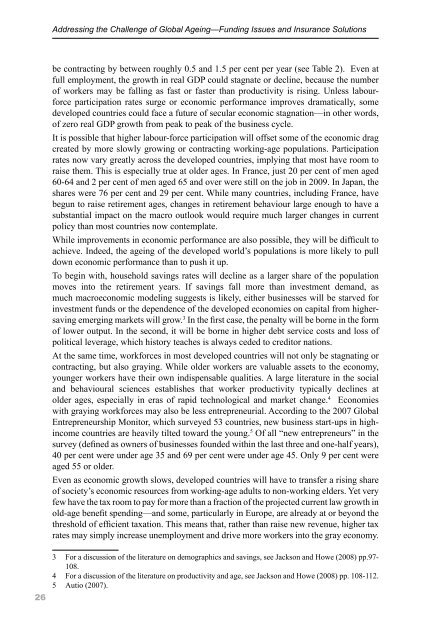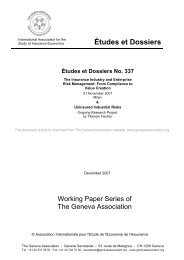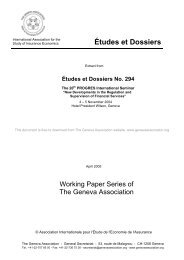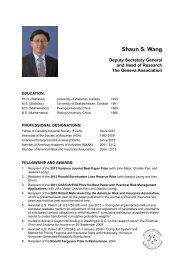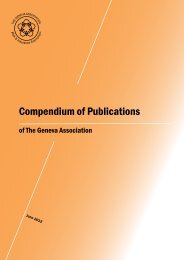Addressing the Challenge of Global Ageing—Funding Issues
Addressing the Challenge of Global Ageing—Funding Issues
Addressing the Challenge of Global Ageing—Funding Issues
You also want an ePaper? Increase the reach of your titles
YUMPU automatically turns print PDFs into web optimized ePapers that Google loves.
26<br />
<strong>Addressing</strong> <strong>the</strong> <strong>Challenge</strong> <strong>of</strong> <strong>Global</strong> Ageing—Funding <strong>Issues</strong> and Insurance Solutions<br />
be contracting by between roughly 0.5 and 1.5 per cent per year (see Table 2). Even at<br />
full employment, <strong>the</strong> growth in real GDP could stagnate or decline, because <strong>the</strong> number<br />
<strong>of</strong> workers may be falling as fast or faster than productivity is rising. Unless labourforce<br />
participation rates surge or economic performance improves dramatically, some<br />
developed countries could face a future <strong>of</strong> secular economic stagnation—in o<strong>the</strong>r words,<br />
<strong>of</strong> zero real GDP growth from peak to peak <strong>of</strong> <strong>the</strong> business cycle.<br />
It is possible that higher labour-force participation will <strong>of</strong>fset some <strong>of</strong> <strong>the</strong> economic drag<br />
created by more slowly growing or contracting working-age populations. Participation<br />
rates now vary greatly across <strong>the</strong> developed countries, implying that most have room to<br />
raise <strong>the</strong>m. This is especially true at older ages. In France, just 20 per cent <strong>of</strong> men aged<br />
60-64 and 2 per cent <strong>of</strong> men aged 65 and over were still on <strong>the</strong> job in 2009. In Japan, <strong>the</strong><br />
shares were 76 per cent and 29 per cent. While many countries, including France, have<br />
begun to raise retirement ages, changes in retirement behaviour large enough to have a<br />
substantial impact on <strong>the</strong> macro outlook would require much larger changes in current<br />
policy than most countries now contemplate.<br />
While improvements in economic performance are also possible, <strong>the</strong>y will be difficult to<br />
achieve. Indeed, <strong>the</strong> ageing <strong>of</strong> <strong>the</strong> developed world’s populations is more likely to pull<br />
down economic performance than to push it up.<br />
To begin with, household savings rates will decline as a larger share <strong>of</strong> <strong>the</strong> population<br />
moves into <strong>the</strong> retirement years. If savings fall more than investment demand, as<br />
much macroeconomic modeling suggests is likely, ei<strong>the</strong>r businesses will be starved for<br />
investment funds or <strong>the</strong> dependence <strong>of</strong> <strong>the</strong> developed economies on capital from highersaving<br />
emerging markets will grow. 3 In <strong>the</strong> first case, <strong>the</strong> penalty will be borne in <strong>the</strong> form<br />
<strong>of</strong> lower output. In <strong>the</strong> second, it will be borne in higher debt service costs and loss <strong>of</strong><br />
political leverage, which history teaches is always ceded to creditor nations.<br />
At <strong>the</strong> same time, workforces in most developed countries will not only be stagnating or<br />
contracting, but also graying. While older workers are valuable assets to <strong>the</strong> economy,<br />
younger workers have <strong>the</strong>ir own indispensable qualities. A large literature in <strong>the</strong> social<br />
and behavioural sciences establishes that worker productivity typically declines at<br />
older ages, especially in eras <strong>of</strong> rapid technological and market change. 4 Economies<br />
with graying workforces may also be less entrepreneurial. According to <strong>the</strong> 2007 <strong>Global</strong><br />
Entrepreneurship Monitor, which surveyed 53 countries, new business start-ups in highincome<br />
countries are heavily tilted toward <strong>the</strong> young. 5 Of all “new entrepreneurs” in <strong>the</strong><br />
survey (defined as owners <strong>of</strong> businesses founded within <strong>the</strong> last three and one-half years),<br />
40 per cent were under age 35 and 69 per cent were under age 45. Only 9 per cent were<br />
aged 55 or older.<br />
Even as economic growth slows, developed countries will have to transfer a rising share<br />
<strong>of</strong> society’s economic resources from working-age adults to non-working elders. Yet very<br />
few have <strong>the</strong> tax room to pay for more than a fraction <strong>of</strong> <strong>the</strong> projected current law growth in<br />
old-age benefit spending—and some, particularly in Europe, are already at or beyond <strong>the</strong><br />
threshold <strong>of</strong> efficient taxation. This means that, ra<strong>the</strong>r than raise new revenue, higher tax<br />
rates may simply increase unemployment and drive more workers into <strong>the</strong> gray economy.<br />
3 For a discussion <strong>of</strong> <strong>the</strong> literature on demographics and savings, see Jackson and Howe (2008) pp.97-<br />
108.<br />
4 For a discussion <strong>of</strong> <strong>the</strong> literature on productivity and age, see Jackson and Howe (2008) pp. 108-112.<br />
5 Autio (2007).


